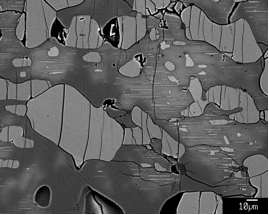2011 Annual Science Report
 University of Hawaii, Manoa
Reporting | SEP 2010 – AUG 2011
University of Hawaii, Manoa
Reporting | SEP 2010 – AUG 2011
Water in Planetary Interiors
Project Summary
We have synthesized samples of high pressure mineral phases that are likely hosts for H, and thus water, in planetary interiors, and measured physical properties including crystal structure, density, elasticity, and electrical conductivity to see if there is evidence of deep hydration in the Earth.
Project Progress
We have synthesized samples of high pressure mineral phases that are likely hosts for H, and thus water, in planetary interiors, and measured physical properties including crystal structure, density, elasticity, and electrical conductivity to see if there is evidence of deep hydration in the Earth. The nominally anhydrous minerals (those without H in the formula) are likely significant host phases for much of the H in and on the Earth and may control the H balance in Terrestrial planets. Nominally hydrous phases may also play a significant role. Nominally anhydrous phases synthesized under hydrous conditions at Bayerisches Geoinstitut (University of Bayreuth, Germany) include olivine, wadsleyite, and ringwoodite (all (Mg,Fe)2SiO4), and clino-enstatite, majorite, akimotoite, and silicate perovskite (all (Mg,Fe)SiO3). Nominally hydrous phases include Phases B and D.
Significant new results in 2011 include synthesis and compressibility of Phase D. Phase D (Mg1.0Si1.7H3.0O6 ) is the likely host for H, and thus water, in the Earth’s lower mantle and may be stable to depths of 1500 km. Phase D is very hydrous and can contain 15% H2O by weight (Hushur et al., 2011), but is very incompressible so that the presence of 3000 ppm by weight H2O in the lower mantle would be difficult to detect seismically. We have observed and documented the epitaxial relations and H distributions among coexisting ringwoodite, ringwoodite, and clinopyroxene (Smyth et al. submitted). We observed the coherent dehydration of hydrous wadsleyite at high temperature and ambient pressure (Ye et al 2011). We measured the thermal expansion of hydrous ringwoodite (Ye at al., 2012).

Backscattered electron image of exsolution texture of wadsleyite (bright) from olivine (darker). The 410 km discontinuity in the Earth is thought to be due to the olivine to wadsleyite transformation. Wadsleyite is capable of incorporating several times the water mass of the Earth’s oceans and may play an important role in the water balance of the planet. The wadsleyite (bright rounded grains and lamellae) are richer in Fe and H relative to the darker olivine.
Publications
-
Ye, Y., Brown, D. A., Smyth, J. R., Panero, W. R., Jacobsen, S. D., Chang, Y-Y., … Frost, D. J. (2012). Compressibility and thermal expansion of hydrous ringwoodite with 2.5(3) wt% H2O. American Mineralogist, 97(4), 573–582. doi:10.2138/am.2012.4010
-
Ye, Y., Smyth, J. R., & Frost, D. J. (2011). Structural study of the coherent dehydration of wadsleyite. American Mineralogist, 96(11-12), 1760–1767. doi:10.2138/am.2011.3852
- Hushur, A., Manghnani, M.H., Smyth, J.R., Williams, Q., Hellebrand, E., Lonappan, D., Ye, Y., Dera, P. & Frost, D.J. (2011). Equation of state of Phase D to 56 GPa. Journal of Geophysical Research, 16.
- Smyth, J.R., Miyajima, N., Hillebrand, E., Huss, G., Rubie, D.C. & Frost, D.J. (2011, Submitted). Olivine-wadsleyite-pyroxene epitaxy: element and volatile distributions at the 410 km discontinuity. Physics of the Earth and Planetary Interiors.
-
PROJECT INVESTIGATORS:
-
PROJECT MEMBERS:
Gary Huss
Unspecified Role
Joseph Smyth
Unspecified Role
-
RELATED OBJECTIVES:
Objective 1.1
Formation and evolution of habitable planets.
Objective 2.1
Mars exploration.
Objective 3.1
Sources of prebiotic materials and catalysts
Objective 3.2
Origins and evolution of functional biomolecules